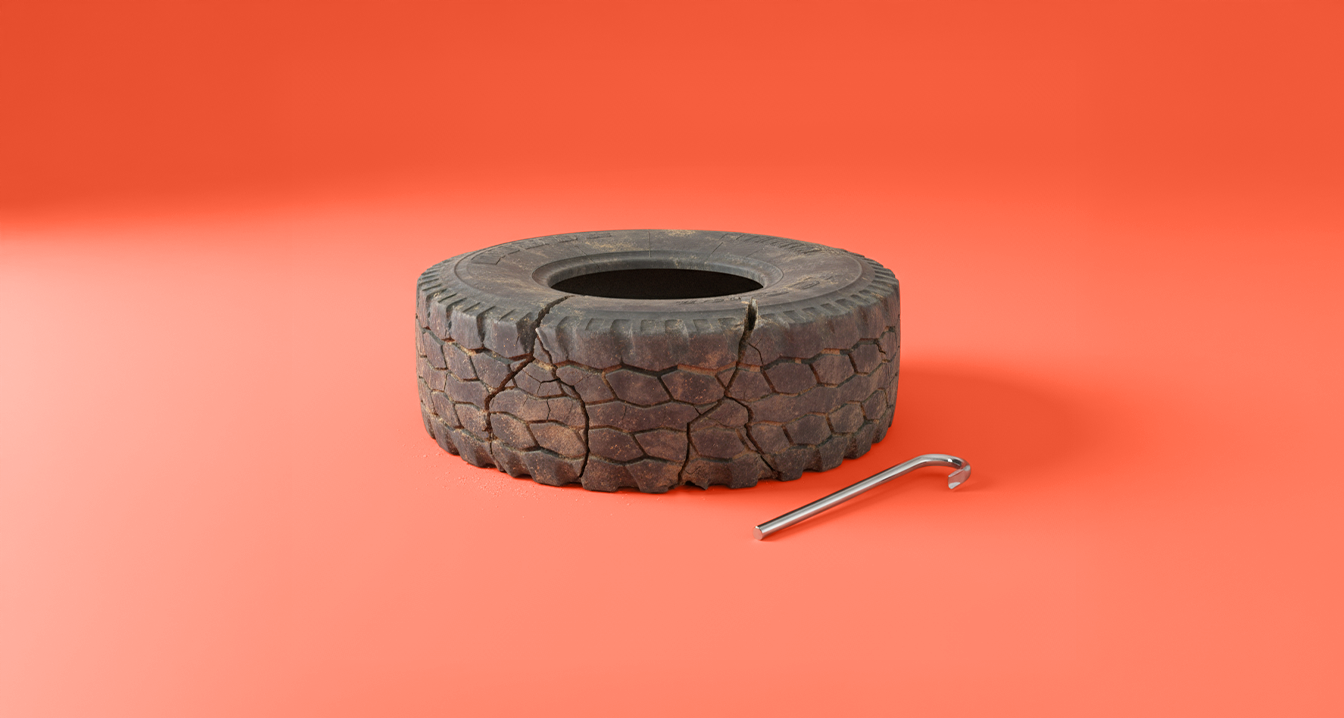Some statistics show that some of the tires sold in the market are recycled tires. Is it safe to install them on your truck?
In this regard, researchers confirm that there are many worn tires for sale in shops selling used tires. It may be difficult for you, and even a tire expert, to see signs of internal damage in them.
When it's time to replace your truck tire, you're faced with an important decision: do you choose brand new tires, or consider the budget-friendly option of used tires?
Both options have pros and cons, so making the right choice depends on different factors, so below we will find out the difference between new and recycled tires, and determine which option is best for you.
Not all used tires are safe. Some of the damage inside them is not even visible to the expert, and the wrong decision may cost you more than you save
The definition of recycled tires and the method of manufacturing them
Recycled tires are tires that are no longer suitable for use in vehicles due to damage, wear or expiration of their shelf life. Therefore, they are subject to a recycling process to convert them into raw materials or products instead of disposing of them in landfills or burning them.
The recycling of used tires aims to reduce the negative environmental impact caused by the accumulation of discarded tires and to recover valuable resources such as rubber, steel and fibers.
The process of manufacturing recycled tires for trucks begins with collecting and examining scrap tires, then cutting and grinding them into small pieces or rubber powder.
Components such as steel and fibers are separated, and the resulting rubber is processed to refine it. Recycled tires are generally not used directly as new truck tires for safety reasons, but recycled materials are used in several truck-related applications.
This includes the use of recycled rubber in the manufacture of new tires for retreaded trucks. Shredded rubber is also used in the manufacture of products such as rubber roadblocks, loading docks, floors in shipping areas and truck parking lots.
You should be careful. Most used tires in the market come from companies that collect old tires and sell them to used tire dealers. They are examined superficially to ensure that there are no visible defects and their ability to retain air while ensuring a minimum pattern, and sometimes they are colored to look new.
Not all used tires are safe, and some carry hidden damage that may not even be visible to an expert.
The difference between new and recycled tires in terms of quality and performance
New and recycled tires vary greatly in terms of quality and performance. New tires are made from new raw materials in accordance with the latest technologies and strict quality standards, ensuring superior and reliable performance in various aspects of driving.
The new tires provide better grip, control and stability in dry, wet and snowy conditions thanks to their new tread design and full depth. They also have higher wear resistance, longer life, and offer higher safety levels in terms of durability and explosion resistance.
The new tires are also subject to thorough quality tests and come with warranties from the manufacturers.
In contrast, recycled tires are not used as whole new tires for trucks, especially in heavy trucks that require maximum safety.
Instead, recycled rubber from used tires is used as a raw material in the manufacture of new tires for refurbished tires, or in other non-essential components in new tires in limited proportions, or in various other products such as playground floors and rubber barriers.
Although reconditioned tires provide an economical and environmentally friendly alternative to new tires in some applications — such as commercial trucks whose tires are commonly reconditioned — they are no match for new tires in terms of overall performance, durability and expected service life.
The quality of reconditioned tires depends largely on the quality of the original structure of the used tire and the quality of the retreading process itself. Other products made from recycled rubber are designed for different applications that do not require the same high performance and safety standards required for new tires.
Therefore, if your priority is to obtain the highest levels of quality, performance, safety, reliability and a longer service life, new tires are the best choice.
While recycled materials from tires play an important role in sustainability and waste reduction, and find useful applications in a variety of fields, they are not considered a direct replacement for new tires when it comes to the performance and quality of tires used in trucks, especially in difficult conditions or critical safety applications.
A refurbished tire is not a disadvantage, but it is not suitable for all conditions or all trucks, and safety always starts with the quality of the tread
Is it recommended to use recycled tires and what are their safety standards?
At the outset, we can explain that in the case of recycled truck tires, the end product is not a fully recycled tire, but a “refurbished tire” that uses used parts, new materials and recycled materials in limited proportions.
The question is: Is it recommended to use retreaded tires? For trucks and commercial vehicles, reconditioned tires are a widely accepted and sustainable option, within specific safety criteria.
Tire retreading offers several benefits to the trucking industry, including:

cost saving
Recycled tires are much cheaper than new tires, reducing operating costs for carriers.
Environmental benefits
Tire recycling reduces the amount of waste from discarded tires and consumes less energy and resources compared to manufacturing completely new tires.
Acceptable performance in some applications
For some truck types and driving conditions, retreaded tires can provide good and acceptable performance, especially on highways and long distances.
Safety standards for retreaded tires for trucks

The manufacture of retreaded tires for trucks is subject to strict safety standards and regulations to ensure their quality and reliability. These standards include:
- The original structure of the used tire should be examined very carefully to ensure that it is free of any damage or defects before starting the renovation process.
- The new tread used in the renovation process must meet specific quality standards in terms of rubber composition, design and depth of the tread.
- The renovation process should be carried out in certified factories that follow standard procedures and specifications to ensure the quality of the renovation and the adhesion of the new tire to the old structure in a safe manner.
- Refurbished tires should have clear signs indicating that they are refurbished tires, the date of renewal, the company that performed the renewal, and any other necessary consumer information.
- Ensure that the reconditioned tires they use comply with all applicable regulations and safety standards in their areas of operation.
Despite the existence of safety standards, reconditioned tires are still generally considered to be less performing and reliable than completely new tires, but they remain a practical and economical option for many commercial transport companies and trucks that operate in routine driving conditions and at moderate speeds.
However, other studies have confirmed that the safety of these tires depends mainly on Regular maintenance, such as adjusting air pressure regularly and taking into account wheel alignment.
Continued technological advancement in the tire industry also makes modern tires, whether new or remanufactured, safer and more efficient than tires made in the past.
How to maintain recycled tires
The maintenance of recycled tires is not fundamentally different from the maintenance of new tires. To ensure the safe performance and long life of your remanufactured tires, it is necessary to follow a periodic and regular maintenance schedule that includes the following aspects:
Weekly or every 10,000 mile tire treads
This is because the tire tread is responsible for the vehicle's stability and its ability to effectively brake and traction, so regular inspection helps you spot signs of abnormal wear, damage, or foreign objects stuck in the tire early on.
You can visually check by looking for uneven wear that may indicate alignment or suspension problems, wear in the center or ends that indicates incorrect air pressure, foreign objects that should be removed, and any cracks or bulges that require a specialized examination.
You can also use a tread depth gauge or a coin to check the remaining depth, and be sure to replace the tire if the depth reaches the legal minimum of 1.6 mm.
Check air pressure
It is preferable to check the air pressure before each trip or at least weekly in order to ensure optimal performance, safety and life of the tire.
Incorrect pressure, whether low or high, also leads to multiple problems, including irregular wear of the tire - the ends in the case of lack of pressure, and the middle in the case of increased pressure - increased fuel consumption due to rolling resistance, deterioration in vehicle control, especially in emergency maneuvers, and increased risk of tire damage and high temperature, which may lead to explosion.
Tire cleanliness
Keeping recycled tires clean is an important preventive step to extend their life and ensure their safety. The accumulation of dirt, debris, oil, and chemicals on tires leads to the deterioration of rubber material and shortens its lifespan.
Also, cleaning tires allows them to be carefully inspected to detect any damage or foreign objects that may be stuck in them. To achieve optimal cleanliness, it is recommended to wash tires regularly using mild vehicle soap and water and a soft brush for the treads and sidewalls.
quiet driving
Aggressive driving, including sudden acceleration and stopping, sharp turns, and high speeds, is one of the main causes of tire deterioration and reduced life.
These practices generate excessive heat and stress on the tires, resulting in faster wear and an increased risk of sudden damage or even tire explosion.
This is especially important with recycled tires, which may be less able to withstand extreme stress than new tires.
Avoid road hazards
Driving over sharp pavement, deep potholes, and hard objects on the road damages tires. These risks cause immediate damage to tires such as cracks, cuts, bulges, or even invisible internal damage that may lead to future problems.
Recycled tires may be more sensitive to these impacts than new tires. Therefore, you should drive carefully and carefully to avoid road hazards as much as possible and reduce driving on rough and unpaved roads that increase tire damage.
Whether your tire is new or refurbished, the secret to a long life is maintenance and attention. Don't neglect air pressure and don't wait for the road to surprise you.
Truck maintenance
Did you know that maintaining a truck periodically and regularly is not only to maintain the truck's performance and efficiency, but also has a direct impact on tire health, life span and driving safety?
Experts confirm that mechanical problems in the truck, such as wheel misalignment, suspension damage, or brake imbalance, can cause irregular tire wear, shorten its life, and increase the risk of accidents. Therefore, comprehensive car maintenance is an essential part of tire maintenance.
Finally, if you are confused about the difference between new and recycled tires, and which is a safe option, you can easily contact the company's support team.”Your path“Where a group of specialists in truck tires will answer you efficiently and transparently to all your questions in this field.







